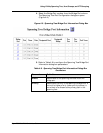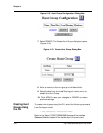
Cajun P550/P880/P882 Switch User Guide
Using VLANs, Spanning Tree, Hunt Groups, and VTP Snooping
4-23
Figure Figure4-14 illustrates how the P550 distributes it PLEs to
load-share hunt group traffic.
Figure 4-14. Load Sharing PLEs
The P550 uses its distributed PLEs to load-share hunt group traffic.
The PLEs are categorized into two groups:
■ member PLE
■ non-member PLE
Member PLE’s service traffic sourced from a particular hunt group.
Members are restricted to selecting one port for all hunt group
related traffic. This port is called the “base” port. This restriction
prevents the system from receiving spurious learn events.
Non-member PLE’s do not service traffic sourced from a particular
hunt group and therefore are free to select any port for hunt-group
destined traffic. The hunt group port that is selected is based on the
source PLE and the destination MAC address. Before this
enhancement, all non-member PLEs chose the same port for a given
destination address. Now, non-member PLEs choose different ports
(modulo the total number of ports in the hunt group) for a given
destination address.
Hunt group ports should be segregated from the ports involved in
traffic flows to the hunt group with respect to the PLE’s servicing
those ports. The greater the number of non-member PLEs in the
system, the greater the ability of the system to load-share.
L2 CPU L2 CPU
20 port 10/100
20 port 10/100
empty
empty
2 Port Gig
2 Port Gig
20 port 10/100
20 port 10/100
empty
empty
2 Port Gig
2 Port Gig
A B C D E F G H
Hunt Group
E-PLE#5
E-PLE#6
PLE#3
PLE#4
PLE#5
PLE#6
PLE#1
PLE#2


















